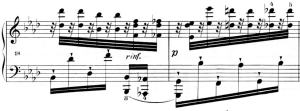Despite the Omega being in its initial acclimatization period and therefore out of tune, one thing is very clear – the factory has prepped the piano to the nines. This is how it should be, but something that only the low-volume high-end manufacturers do. Other manufacturers leave it to their dealers to do a good prep before or immediately after delivery. By prepping pianos thoroughly in the factory Sauter ensures that the piano is performing at it’s best, and that the company’s reputation for quality is not dependent on somebody else over whom they have little or no control. I am not saying that no post-delivery prep work is needed, but that the chances of needing major remedial work are pretty slim. That’s assuming that the piano has been well-treated in shipping.
The Action
Action regulation feels great. Fine control of the Omega’s enormous dynamic range is easy. The importance of this cannot be overstated. That’s why so many pianists, even beginners who think that they can’t benefit from an expensive grand piano, suddenly find that the piano seems to be playing them and not the other way around.
The dynamic touch weight initially felt heavy because some things that I could do on the Kawai K-8 and the Roland A-80 keyboards I could not do on the Omega. But after experimenting for a while on Saturday I have changed my mind. I can now do some things on the Omega that I struggled with before. Here are two examples from Beethoven’s Op. 26, first movement:
- In Var II, bar 18-19, the rinforzando at the end of bar 18 should be played mf with pedal, after which the touch returns to staccato in the left-hand and dynamic level at p.
- In Var. IV, bar 26 the descending scale in the left hand has to be played with a portato touch, going from f to pp, and a little ritardando.
These were difficult to do before, but not on the Omega.
As for the heavier dynamic touch weight, well the extra hand and forearm strength will be acquired soon enough. I have already adapted enough to fix what I couldn’t play on the Omega before.
I also have to remember to not be afraid to play deep into the keys. Previously, control of pp was difficult so I tended to back off just before the end of the keystroke on soft notes. It’s like pulling a punch. Don’t need to do this on the Omega. In fact, you cannot pull your fingerstrokes on the Omega if you want a good tone.
Damper Effectiveness
On many pianos, when you play a note and release the key, there is a lot of overhang because the dampers don’t quench the vibrations in the string quickly enough, there is sympathetic resonance in other strings (even though they may be damped), and the plate rings more than it should. In the Omega, the dampers quench vibrations quickly, and what little audible overhang there is comes from the soundboard. This means that poor finger legato is very quickly revealed, as is inadequate pedal technique.
The Voice
The Omega’s voice is, in one word, glorious. It is full, rich, complex, articulate, clear, and yet creamy and rounded. The tonal palette at different loudness levels in the dynamic range from ppp to fff is beautiful. It is tonally even across the keyboard, with the tenor and treble breaks being very hard to spot.
It’s Not Loud
So many people told me that I was crazy to put a 220cm grand piano in my living room. Too loud, they said. Wrong! The Omega, with its enormous and controllable dynamic range and a keyboard that does not require you to pull your fingerstrokes to play softly, is no louder than my Kawai K-8. But when I want the Omega to roar, oh boy, roar he does!

